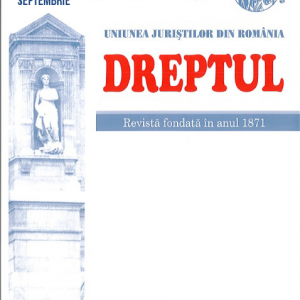-
 The establishment of the European arrest warrant at the European Union level, which actually replaced extradition, is, without any doubt, an important success of the Member States in the fight against cross-border crime. The execution of a European arrest warrant by the relevant Romanian judicial authorities, in the case of cross-border crimes, involves several specificities of this type of crimes, with direct implications over the entire European judicial system. The specificities identified by the authors in the paper include the execution of the mandate, even when the double crime condition is not fulfilled, the possibility of the Romanian competent courts to order the execution of a European arrest warrant, even when the crime for which the execution is demanded does not have the same name as in Romanian, the possibility of the relevant Romanian court to order the execution of the European arrest warrant, even if the crime for which such execution is requested is not provided by the Romanian law, but the content of the crime provided by the Member State law has similarities with a crime provided by our legislation etc. The analysis also revealed certain aspects related to the need to amend and supplement the special law (and the European piece of legislation) that should in line with the European legislation in the field.
The establishment of the European arrest warrant at the European Union level, which actually replaced extradition, is, without any doubt, an important success of the Member States in the fight against cross-border crime. The execution of a European arrest warrant by the relevant Romanian judicial authorities, in the case of cross-border crimes, involves several specificities of this type of crimes, with direct implications over the entire European judicial system. The specificities identified by the authors in the paper include the execution of the mandate, even when the double crime condition is not fulfilled, the possibility of the Romanian competent courts to order the execution of a European arrest warrant, even when the crime for which the execution is demanded does not have the same name as in Romanian, the possibility of the relevant Romanian court to order the execution of the European arrest warrant, even if the crime for which such execution is requested is not provided by the Romanian law, but the content of the crime provided by the Member State law has similarities with a crime provided by our legislation etc. The analysis also revealed certain aspects related to the need to amend and supplement the special law (and the European piece of legislation) that should in line with the European legislation in the field. -
 The authors look at the equipollence principle – related to the moment when the period for the enforcement of a mechanism of redress starts to run – mostly in terms of the case law. Starting from the publication, a short time ago, of the decision issued in a case by the Criminal Section of the High Court of Cassation and Justice, note is taken of the fact that the case law of the supreme judicial authority in criminal matters has varied in this respect in time, starting by the acceptance and enforcement of this principle, followed by the denial of its applicability, and then by its re-enforcement. As regards the same principle, the judicial practice of the High Court of Cassation and Justice in the civil trial-related matter is unitary and constant, meaning that the equipollence theory strictly applies to the cases expressly regulated by law, and no cases when equipollence is also applied for other assumptions as well are identified. The conclusion is that the inconsistencies between the criminal and civil trial-related matters in terms of legislative, doctrine-related and case law approach of this principle, underlined throughout the analysis, should be eliminated both by legislative amendments and by judicial practice unification mechanisms.
The authors look at the equipollence principle – related to the moment when the period for the enforcement of a mechanism of redress starts to run – mostly in terms of the case law. Starting from the publication, a short time ago, of the decision issued in a case by the Criminal Section of the High Court of Cassation and Justice, note is taken of the fact that the case law of the supreme judicial authority in criminal matters has varied in this respect in time, starting by the acceptance and enforcement of this principle, followed by the denial of its applicability, and then by its re-enforcement. As regards the same principle, the judicial practice of the High Court of Cassation and Justice in the civil trial-related matter is unitary and constant, meaning that the equipollence theory strictly applies to the cases expressly regulated by law, and no cases when equipollence is also applied for other assumptions as well are identified. The conclusion is that the inconsistencies between the criminal and civil trial-related matters in terms of legislative, doctrine-related and case law approach of this principle, underlined throughout the analysis, should be eliminated both by legislative amendments and by judicial practice unification mechanisms. -
 Law no. 202/2010 on certain measures regarding the acceleration of the settlement of lawsuits, the so-called “small reform”, was adopted in order to accelerate the settlement of lawsuits, by ensuring the swiftness of procedures, both in criminal matters and in civil matters, even before the expected entry into force of the new codes (the Criminal Code, the Criminal Procedure Code, the Civil Code, the Civil Procedure Code). In the field of criminal prosecution, certain provisions of the current Criminal Procedure Code were amended, with a view to ensuring swiftness by eliminating the provisions that required the court intervention for the revocation or termination of certain preventive measures if the prosecutor issues a decision for the non-initiation of court proceedings; however, no amendments were correlatively made to other provisions of the code in relation thereto. Therefore, certain disputes might arise in connection with the implementation of such texts of law.
Law no. 202/2010 on certain measures regarding the acceleration of the settlement of lawsuits, the so-called “small reform”, was adopted in order to accelerate the settlement of lawsuits, by ensuring the swiftness of procedures, both in criminal matters and in civil matters, even before the expected entry into force of the new codes (the Criminal Code, the Criminal Procedure Code, the Civil Code, the Civil Procedure Code). In the field of criminal prosecution, certain provisions of the current Criminal Procedure Code were amended, with a view to ensuring swiftness by eliminating the provisions that required the court intervention for the revocation or termination of certain preventive measures if the prosecutor issues a decision for the non-initiation of court proceedings; however, no amendments were correlatively made to other provisions of the code in relation thereto. Therefore, certain disputes might arise in connection with the implementation of such texts of law. -
 The excessive activity of the criminal trial-related law in the case of transient situations can ensure the predictable nature of law and the elimination of the cases when the parties are harmed by the limitation of the mechanisms of redress. The reporting of the implementation of the criminal trial-related law regarding hearings and mechanisms of redress upon the court’s notification provides to the parties sufficient prediction as regards the knowledge of such hearings and mechanisms of redress since the initial moment of the judgment phase. The author appreciates that such an approach in the law implementing the new Criminal Procedure Code would ensure an efficient transition from the old criminal trial-related law to the new criminal trial-related law.
The excessive activity of the criminal trial-related law in the case of transient situations can ensure the predictable nature of law and the elimination of the cases when the parties are harmed by the limitation of the mechanisms of redress. The reporting of the implementation of the criminal trial-related law regarding hearings and mechanisms of redress upon the court’s notification provides to the parties sufficient prediction as regards the knowledge of such hearings and mechanisms of redress since the initial moment of the judgment phase. The author appreciates that such an approach in the law implementing the new Criminal Procedure Code would ensure an efficient transition from the old criminal trial-related law to the new criminal trial-related law. -
 The article reviews the organized crime phenomenon, as cross-border and multinational crime. The first section substantiates the concepts, both from a doctrine-related and a legislative perspective. An important part in terms of content and scope is dedicated to the analysis of European policies and strategies, emphasizing the security strategy of the European Union. The last part presents certain solutions for fighting against the cross-border crime phenomenon.
The article reviews the organized crime phenomenon, as cross-border and multinational crime. The first section substantiates the concepts, both from a doctrine-related and a legislative perspective. An important part in terms of content and scope is dedicated to the analysis of European policies and strategies, emphasizing the security strategy of the European Union. The last part presents certain solutions for fighting against the cross-border crime phenomenon. -
 Constrângerea moralã, cauzã care înlãturã caracterul penal al faptei prevãzute în art. 46 alin. 2 C.pen., presupune îndeplinirea urmãtoarelor condiþii: sã existe o acþiune de constrângere exercitatã de o persoanã asupra psihicului unei alte persoane, prin ameninþare; ameninþarea sã creeze un pericol grav pentru fãptuitor sau pentru o altã persoanã, în cazul în care nu ar sãvârºi fapta prevãzutã de legea penalã; pericolul cu care se ameninþã sã nu poatã fi înlãturat decât prin sãvârºirea faptei prevãzute de legea penalã.
Constrângerea moralã, cauzã care înlãturã caracterul penal al faptei prevãzute în art. 46 alin. 2 C.pen., presupune îndeplinirea urmãtoarelor condiþii: sã existe o acþiune de constrângere exercitatã de o persoanã asupra psihicului unei alte persoane, prin ameninþare; ameninþarea sã creeze un pericol grav pentru fãptuitor sau pentru o altã persoanã, în cazul în care nu ar sãvârºi fapta prevãzutã de legea penalã; pericolul cu care se ameninþã sã nu poatã fi înlãturat decât prin sãvârºirea faptei prevãzute de legea penalã.
